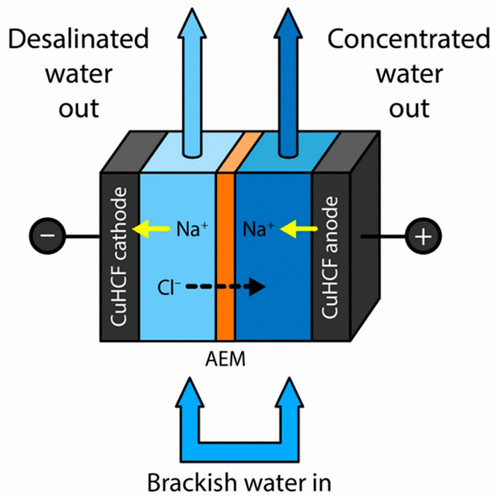当前位置:
X-MOL 学术
›
Environ. Sci. Technol. Lett.
›
论文详情
Our official English website, www.x-mol.net, welcomes your
feedback! (Note: you will need to create a separate account there.)
Low Energy Desalination Using Battery Electrode Deionization
Environmental Science & Technology Letters ( IF 8.9 ) Pub Date : 2017-09-21 00:00:00 , DOI: 10.1021/acs.estlett.7b00392 Taeyoung Kim 1 , Christopher A. Gorski 1 , Bruce E. Logan 1
Environmental Science & Technology Letters ( IF 8.9 ) Pub Date : 2017-09-21 00:00:00 , DOI: 10.1021/acs.estlett.7b00392 Taeyoung Kim 1 , Christopher A. Gorski 1 , Bruce E. Logan 1
Affiliation

|
New electrochemical technologies that use capacitive or battery electrodes are being developed to minimize energy requirements for desalinating brackish waters. When a pair of electrodes is charged in capacitive deionization (CDI) systems, cations bind to the cathode and anions bind to the anode, but high applied voltages (>1.2 V) result in parasitic reactions and irreversible electrode oxidation. In the battery electrode deionization (BDI) system developed here, two identical copper hexacyanoferrate (CuHCF) battery electrodes were used that release and bind cations, with anion separation occurring via an anion exchange membrane. The system used an applied voltage of 0.6 V, which avoided parasitic reactions, achieved high electrode desalination capacities (up to 100 mg-NaCl/g-electrode, 50 mM NaCl influent), and consumed less energy than CDI. Simultaneous production of desalinated and concentrated solutions in two channels avoided a two-cycle approach needed for CDI. Stacking additional membranes between CuHCF electrodes (up to three anion and two cation exchange membranes) reduced energy consumption to only 0.02 kWh/m3 (approximately an order of magnitude lower than values reported for CDI), for an influent desalination similar to CDI (25 mM decreased to 17 mM). These results show that BDI could be effective as a very low energy method for brackish water desalination.
中文翻译:

使用电池电极去离子的低能脱盐
正在开发使用电容电极或电池电极的新电化学技术,以最大程度地减少淡化咸水的能量需求。在电容性去离子(CDI)系统中为一对电极充电时,阳离子会与阴极结合,而阴离子会与阳极结合,但是高施加电压(> 1.2 V)会导致寄生反应和不可逆的电极氧化。在这里开发的电池电极去离子(BDI)系统中,使用了两个完全相同的六氰合铁酸铜(CuHCF)电池电极,它们释放并结合阳离子,并通过阴离子交换膜进行阴离子分离。该系统使用0.6 V的施加电压,避免了寄生反应,实现了高电极脱盐能力(高达100 mg-NaCl / g电极,50 mM NaCl进水),并且消耗的能量少于CDI。在两个通道中同时生产淡化和浓缩溶液,避免了CDI所需的两周期方法。在CuHCF电极之间堆叠额外的膜(最多三个阴离子和两个阳离子交换膜)可将能耗降低到仅0.02 kWh / m3(比CDI报告的值低一个数量级),类似于CDI的进水淡化(25 mM降低到17 mM)。这些结果表明,BDI可以作为一种低能耗的微咸水淡化方法。
更新日期:2017-09-21
中文翻译:

使用电池电极去离子的低能脱盐
正在开发使用电容电极或电池电极的新电化学技术,以最大程度地减少淡化咸水的能量需求。在电容性去离子(CDI)系统中为一对电极充电时,阳离子会与阴极结合,而阴离子会与阳极结合,但是高施加电压(> 1.2 V)会导致寄生反应和不可逆的电极氧化。在这里开发的电池电极去离子(BDI)系统中,使用了两个完全相同的六氰合铁酸铜(CuHCF)电池电极,它们释放并结合阳离子,并通过阴离子交换膜进行阴离子分离。该系统使用0.6 V的施加电压,避免了寄生反应,实现了高电极脱盐能力(高达100 mg-NaCl / g电极,50 mM NaCl进水),并且消耗的能量少于CDI。在两个通道中同时生产淡化和浓缩溶液,避免了CDI所需的两周期方法。在CuHCF电极之间堆叠额外的膜(最多三个阴离子和两个阳离子交换膜)可将能耗降低到仅0.02 kWh / m3(比CDI报告的值低一个数量级),类似于CDI的进水淡化(25 mM降低到17 mM)。这些结果表明,BDI可以作为一种低能耗的微咸水淡化方法。


















































 京公网安备 11010802027423号
京公网安备 11010802027423号